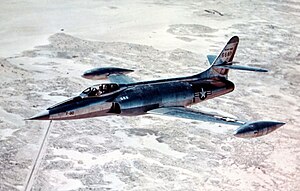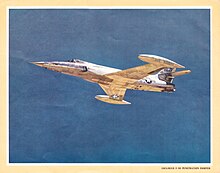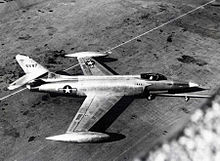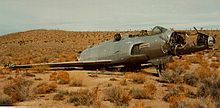avia.wikisort.org - Aeroplane
The Lockheed XF-90 was built in response to a United States Air Force requirement for a long-range penetration fighter and bomber escort. The same requirement produced the McDonnell XF-88 Voodoo. Lockheed received a contract for two prototype XP-90s (redesignated XF-90 in 1948). The design was developed by Willis Hawkins and the Skunk Works team under Kelly Johnson. Two prototypes were built (s/n 46-687 and -688). Developmental and political difficulties delayed the first flight until 3 June 1949, with Chief Test Pilot Tony LeVier at the controls. Embodying the experience gained in developing the P-80 Shooting Star, the XF-90 shared some design traits with the older Lockheed fighter, albeit with swept-wings; however, this latter design choice could not sufficiently make up for the project’s underpowered engines,[1] and the XF-90 never entered production.
| XF-90 | |
|---|---|
 | |
| XF-90 in flight | |
| Role | Fighter |
| Manufacturer | Lockheed |
| First flight | 3 June 1949 |
| Status | Canceled |
| Number built | 2 |
Design and development

In response to a 1945 Army request for an advanced jet fighter, Lockheed proposed a jet powered initially by a Lockheed L-1000 axial flow turbojet, and then the General Electric J35.[2] Further design refinements included using two Westinghouse J34 engines with afterburners. After data showed that a delta planform would not be suitable, the Lockheed Model 90 was built in 1947 as a mock-up.[3]
The final design embodied much of the experience and shared the intake and low-wing layout of the previous P-80 Shooting Star, but with 35° swept-back wings, a sharply-pointed nose, and two Westinghouse J34-WE-11 axial-flow turbojet engines, providing a total thrust of 6,200 lbf (27.6 kN), mounted side-by-side in the rear fuselage and fed by side-mounted air intakes.[1] The wings had leading edge slats, Fowler flaps, and ailerons on the trailing edge. The pressurized cockpit was fitted with an ejection seat and a bubble canopy. Proposed armament was six 20 mm (.79 in) cannons. The internal fuel was supplemented by wingtip-mounted tanks, bringing total fuel capacity to 1,665 gal (6,308 L). The use of 75ST aluminum rather than the then-standard 24ST aluminum alloy, along with heavy forgings and machined parts, resulted in a well-constructed, sturdy airframe. These innovations resulted in an aircraft with an empty weight more than 50% heavier than its competitors.[1]
The first XF-90 used non-afterburning J34s, but these lacked the thrust for takeoff as rocket-assisted RATO were required for most of the first flights unless it carried a very low fuel load. The second (XF-90A) had afterburners installed which had been tested on an F-80 testbed. Even so, the aircraft remained underpowered.[1]
Testing and evaluation


The XF-90 was the first USAF jet with an afterburner and the first Lockheed jet to fly supersonic, albeit in a dive. It also incorporated an unusual vertical stabilizer that could be moved fore and aft for horizontal stabilizer adjustment. Partly because Lockheed's design proved underpowered, it placed second to McDonnell's XF-88 Voodoo which won the production contract in September 1950, before the penetration fighter project was abandoned altogether.
Upon Lockheed losing the production contract, the two prototypes were retired to other testing roles. The first aircraft (46-687) was shipped to the NACA Laboratory in Cleveland, Ohio in 1953 for structural tests. It was no longer flyable, and its extremely strong airframe was tested to destruction. The other (46-688) survived three atomic blasts at Frenchman Flat within the Nevada Test Site in 1952.
Notable appearances in media
The XF-90 lived on as the jet fighter aircraft flown by the popular Blackhawks Squadron in the comic book series of the same name, first published by Quality Comics and later by DC Comics. The Blackhawks flew fictional "B" and later "C" models all through the 1950s until 1964. Both were improved, single engine production variants of the original twin-engine Lockheed XF-90.[4]
Aircraft disposition
- 46-0687 – tested to destruction at NACA lab in Cleveland, Ohio.[5]
- 46-0688 – in storage, awaiting restoration at the National Museum of the United States Air Force in Dayton, Ohio. In 2003, the heavily damaged hulk was recovered from the Nevada Test Site and moved there. It is currently undergoing minor restoration in one of the Museum's restoration facility hangars. Its wings have been removed, and its nose was mangled by the nuclear blasts. During the decontamination process, all rivets were removed to purge radioactive sand. The aircraft is now on display in the museum's Cold War gallery in a diorama depicting it on the Nevada Test Site.[6] [7]
Specifications (XF-90A)

General characteristics
- Crew: one
- Length: 56 ft 2 in (17.12 m)
- Wingspan: 40 ft 0 in (12.20 m)
- Height: 15 ft 9 in (4.80 m)
- Wing area: 345 sq ft (32 m2)
- Empty weight: 18,050 lb (8,204 kg)
- Gross weight: 27,200 lb (12,363 kg)
- Max takeoff weight: 31,060 lb (14,118 kg)
- Powerplant: 2 × Westinghouse J34-WE-15 turbojets, 4,100 lbf (18 kN) thrust each
Performance
- Maximum speed: 665 mph (1,064 km/h, 578 kn)
- Range: 2,300 mi (3,680 km, 2,000 nmi)
- Service ceiling: 39,000 ft (11,890 m)
- Rate of climb: 5,555 ft/min (28.2 m/s)
- Wing loading: 79 lb/sq ft (386 kg/m2)
- Thrust/weight: 0.30
Armament
- 6 × 20 mm (.79 in) cannons
- 8 × 5 in (127 mm) HVAR rockets
- Up to 2,000 lb (907 kg) of bombs
See also
Aircraft of comparable role, configuration, and era
Related lists
- List of Lockheed aircraft
- List of fighter aircraft
- List of military aircraft of the United States
References
Notes
- Jones 1975, p. 241.
- Jenkins 2008, p. 138.
- O'Leary 1994, p. 18.
- Greenberger 2008, p. 94.
- "XF-90/46-687." Joe Baugher serial numbers. Retrieved: 10 May 2013.
- "XF-90/46-688" National Museum of the United States Air Force. Retrieved: 15 July 2017.
- National Museum of the United States Air Force. Retrieved: 18 September 2021.
Bibliography
- Boyne, Walter J. Beyond the Horizons: The Lockheed Story. New York: St. Martin's Press, 1998. ISBN 0-312-19237-1.
- Greenberger, Robert. "Blackhawk". In Dougall, Alastair. The DC Comics Encyclopedia. London: Dorling Kindersley, 2008. ISBN 0-7566-4119-5.
- Jenkins, Dennis R. and Tony R. Landis. Experimental & Prototype U.S. Air Force Jet Fighters. North Branch, Minnesota: Specialty Press, 2008. ISBN 978-1-58007-111-6.
- Jones, Lloyd S. U.S. Fighters: Army-Air Force 1925 to 1980s. Fallbrook, California: Aero Publishers Inc., 1975. ISBN 0-8168-9200-8.
- Knaack, Marcelle Size. Encyclopedia of US Air Force Aircraft and Missile Systems: Volume 1 Post-World War II Fighters 1945–1973. Washington, DC: Office of Air Force History, 1978. ISBN 0-912799-59-5.
- O'Leary, Michael, ed. "Deep Penetration", America's Forgotten Wings, Volume 1, 1994.
- Pace, Steve. Lockheed Skunk Works. St. Paul, Minnesota: Motorbooks International, 1992. ISBN 0-87938-632-0.
- Pace, Steve. X-Fighters: USAF Experimental and Prototype Fighters, XP-59 to YF-23. St. Paul, Minnesota: Motorbooks International, 1991. ISBN 0-87938-540-5.
- Simone, William J. Lockheed XF-90 Penetration Fighter, Air Force Legends 222. Simi Valley, California, Steve Ginter, 2020. ISBN 978-0-9993884-7-1.
External links
На других языках
[de] Lockheed XF-90
Die Lockheed XF-90 war ein Ende der 1940er Jahre entwickeltes Jagdflugzeug für die United States Army Air Forces (USAAF). Lockheed produzierte nur zwei Prototypen.- [en] Lockheed XF-90
[fr] Lockheed XF-90
Le Lockheed XF-90 a été construit en réponse à une demande de l'United States Air Force d'un chasseur de pénétration à longue portée, escorteur de bombardier. La même demande a conduit au XF-88 Voodoo chez McDonnell. Lockheed a obtenu un contrat pour deux prototypes XP-90 (rebaptisés XF-90 en 1948). Le design a été développé par Willis Hawkins (en) et les équipes du Skunk Works dirigées par Kelly Johnson. Deux prototypes ont été réalisés (s/n 46-687 et -688). Des problèmes tant politiques que techniques ont retardé le projet jusqu'au premier vol le 3 juin 1949, avec le chef pilote d'essais Tony LeVier aux commandes. Les performances ont été jugées insuffisantes en raison d'une trop faible puissance, et le XF-90 n'est jamais entré en production.Другой контент может иметь иную лицензию. Перед использованием материалов сайта WikiSort.org внимательно изучите правила лицензирования конкретных элементов наполнения сайта.
WikiSort.org - проект по пересортировке и дополнению контента Википедии